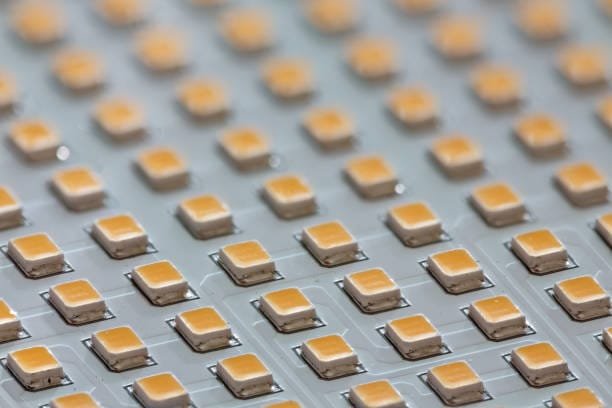Copper Based PCB, Copper Core PCB
Specializing in the production of high-quality copper-based PCB
Home » PCB Manufacturing » Copper Based PCB, Metal Core PCB Manufacturer
What Is MCPCB?
What is Metal Core PCB?
PCBs are used in almost every industry, so there are different types of PCBs available according to the requirements. Nowadays, many applications require quick heat dissipation, high mechanical strength, and shape retainment in the PCB. All these features can be found in the metal core PCBs.
Metalcore PCBs are the best when it comes to heat dissipation. They have gained a lot of importance because of their heat dissipation feature. They can quickly dissipate the heat, which increases the components’ lives and protects them from thermal stress. Today, metal core PCBs are widely used, especially in LED lighting and high-frequency applications.
There are commonly three types of metal core PCBs; aluminum core PCB, iron core PCB, and copper core PCB. These are used for different purposes, but the best of all is the copper core PCB. It is the most expensive metal core PCB, and it offers optimum performance.
Table of Contents

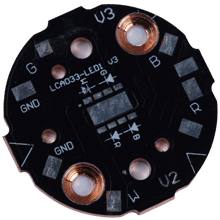
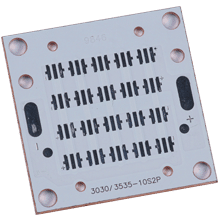
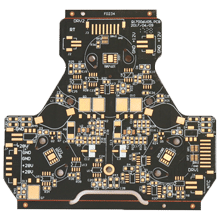
What is Copper Core PCB?
What is Copper Based PCB?
Copper-based PCB or copper core PCB is a metal core PCB that uses copper as the base material in place of commonly used FR4. Like all metal core PCBs, it also has three main layers. The top layer is made of copper, which is responsible for the electrical connection between the components. This layer is standard in all types of PCBs. The second layer is the dielectric layer that prevents current from the top layer to the base layer. Although this layer is electrically an insulator, it is a good conductor of heat. It transfers the heat produced by the components and helps in heat dissipation. The bottom layer of the PCB is copper, which is why it is a copper core PCB.
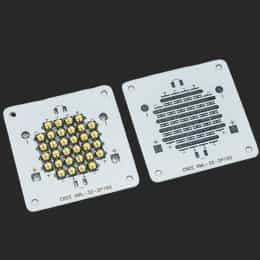
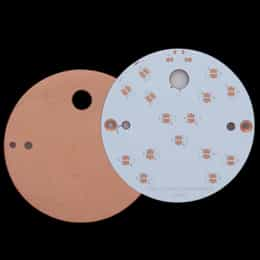
How Are Copper Core PCB Made?
Structure of Coper Based PCB Board
The copper-based PCB’s circuit layer must have a sizeable current-carrying capacity, so thicker copper foil should be used. Its thickness is generally 35μm~280μm. The thermally conductive insulating layer is the copper based’s core technology, and the core thermal conductive components are aluminum oxide and silicon powder.
The epoxy resin-filled polymer composition has low thermal resistance (0.15), excellent viscoelasticity, thermal aging resistance, and the ability to withstand mechanical and thermal stress.
Moreover, the copper Core PCB’s metal base is the supporting member of the copper Core PCB, which requires high thermal conductivity. It is generally a copper plate suitable for conventional machinings such as drilling, punching, and cutting. The metal layer (block) mainly plays a role in heat dissipation, shielding, covering, or grounding.

Structure of Coper Based PCB Board

Schematic diagram of copper-based PCB heat dissipation
Unique Copper Core PCB
Expensive, But Excellent Performance
Due to the differences in copper and aluminum performance and the corresponding PCB processing technology, copper core PCB has more performance advantages than aluminum PCB.
Copper core PCBs are very expensive, but they provide the best performance among all-metal core PCBs. These PCBs are used for particular purposes, including high-frequency circuits and high-temperature variations. They can dissipate heat better than iron and aluminum core PCBs.
Multilayer Metal Core PCB Manufacturer
China Copper Base PCB
The Types of Copper Based PCB
Copper-based/core PCBs can be classified based on surface finish and Manufacturing process. There can be different types of surface finish and fabrication processes as required by the buyer. According to different types of surface finish fabrication processes, the commonly used copper core PCB types are Thermoelectric Separation Copper Core PCB, Hot Air Solder Level(HASL) Copper Based PCB, Anti-oxidation Copper Based PCB, Silver-plated Copper Core PCB, Immersion Gold Copper Based PCB, Immersion Tin Copper Base PCB, Immersion Silver Copper Based PCB, etc.
The circuit part and the thermal layer part of the thermoelectric separation substrate are on different circuit layers. The thermal layer part directly contacts the heat dissipation part of the lamp bead to achieve good heat dissipation and heat conduction (zero thermal resistance). According to the lamps’ different design otherfferent structures (copper bumps, copper concave blocks, thermal layer, and circuit layer parallel) can be made. It has the production capacity of double-sided copper substrates!
The thermoelectric separation technology is relatively complicated and difficult to produce. The thermoelectric separation copper-based PCB includes a circuit layer, a solder mask layer, and a silkscreen character layer.
ENIG is a very common surface finish used for copper PCBs. It is also common in other types of PCBs. The surface finish has a thick layer of nickel over the copper circuit and a thin layer of gold above the nickel layer. The thin layer of gold protects the surface and offers a long life to the PCB. Due to the use of gold, this surface finish is a bit expensive. It is a RoHS compliant surface finish, which is the reason it is preferred.
In this type of copper core PCB, a thin silver layer is used over the copper circuit layer. This layer of silver has excellent conductivity, and it protects the copper surface from oxidation. It is also RoHS compliant and has a reasonable cost.
HASL is the simplest type of surface finish. It has a low cost, which means the copper PCB will have a reasonable price. Molten solder is applied on the surface to protect it from the atmosphere.
HASL contains lead, which is the reason it is not RoHS compliant, but there is also lead-free HASL available. It is only suitable if you want to place large components on the copper PCB.
According to the use scene and purpose, it can be divided into Industrial and Mining Lamp Copper Based PCB, High Pole Lamp Copper Based PCB, Prison Wall Lamp Copper Based PCB, Fishing Lamp Copper Based PCB, Ship Lighting Copper Based PCB, Special Lighting Copper Based PCB, Robot Lighting Copper Based PCB, Flashlight Copper Based PCB, UV Curing Copper Based PCB, Stadium Lamp Copper Based PCB, Spotlight Copper Based PCB, COB Copper Based PCB, Package Copper Based PCB, Power Supply Copper Based PCB, Automobile Lamp Copper Based PCB, etc.
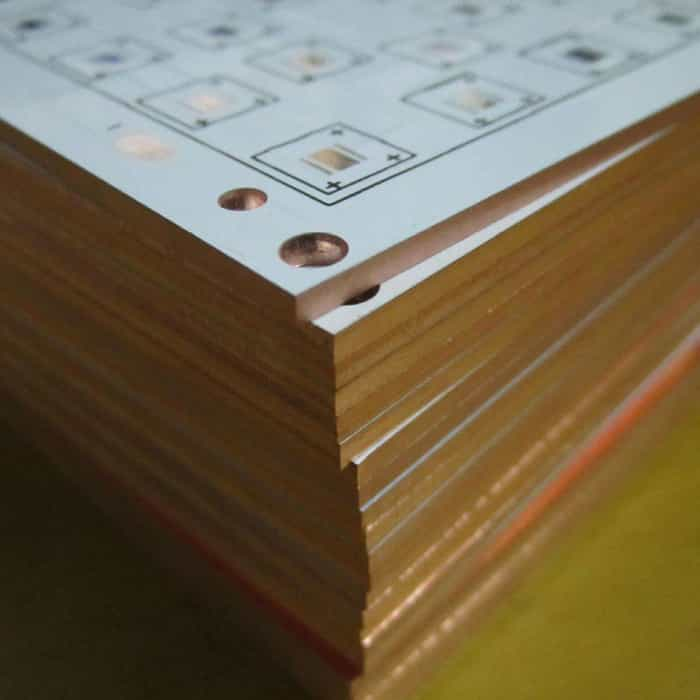
The Advantages of Copper Based PCB
The most important advantage of copper clad PCB is its high thermal conductivity. The PCB can transfer heat quickly and efficiently. If there are high heat emitting components, then a copper-based PCB is an ideal choice. It does not need heat sinks because the copper base is more than enough to dissipate heat. The components remain intact and perfect for a long time. In high-temperature regions or where there are high and low-temperature variations, copper core PCBs can work extremely well.
Copper core PCBs have excellent electric performance. These PCBs are ideal for high-frequency applications and precision communication equipment’ heat dissipation.
Copper core PCBs can retain their shape. They are not like FR-4 or other material that can bend due to high temperature or pressure stress. They retain the shape and do not expand on high operating temperatures. Any shape can be made with a copper base PCB according to requirements. The dimensions of the PCB remain the same, even in harsh conditions.
Copper core PCBs are more durable than aluminum and iron-based PCBs. They have commendable mechanical strength, which can help the PCB and components to last for a long time. They can bear more temperature and pressure stress. Moreover, copper core PCBs can easily bear wear and tear.
Copper Core PCB VS Aluminum PCB
The heat transferring capability of copper is more than aluminum. Its thermal conductivity is twice of the aluminum’s thermal conductivity. The higher the thermal conductivity, the higher the heat transfer efficiency, and the better the heat dissipation performance. Thus, Copper Based PCB dissipates heat efficiently.
The copper base is more durable than aluminum. It can bear more wear and tear under high temperature and pressure stress.
Copper-based PCBs can be processed into metalized holes, but aluminum-based PCBs cannot. The network of metalized holes must be the same so that the signal has good grounding performance. Secondly, copper itself has weldability so that electronic components can be directly welded.
The copper base of the copper core PCB can be etched into delicate patterns and processed into a boss shape. The components can be directly attached to the boss to achieve excellent grounding and heat dissipation effects.
Copper core PCBs offer better dimensional stability than aluminum core PCBs. Copper resists elasticity and prevents any change in the dimensions or deformity in the case of mechanical stress.
The elastic modulus of copper is about 121,000 MPa, and that of aluminum is 72,000 MPa. The corresponding warpage and shrinkage of the copper substrate will be smaller than that of the aluminum substrate, and the overall performance will be more stable.
The weight of a copper-based PCB is more than an aluminum-based PCB. Copper is heavier than aluminum, which is the reason the final PCB is also heavier.
In terms of cost, copper core PCB is expensive as compared to aluminum. The reason behind its cost is the high price of copper. In contrast, aluminum is cheaply available.
Both aluminum and copper are non-magnetic materials. So there is no difference in their magnetic property.
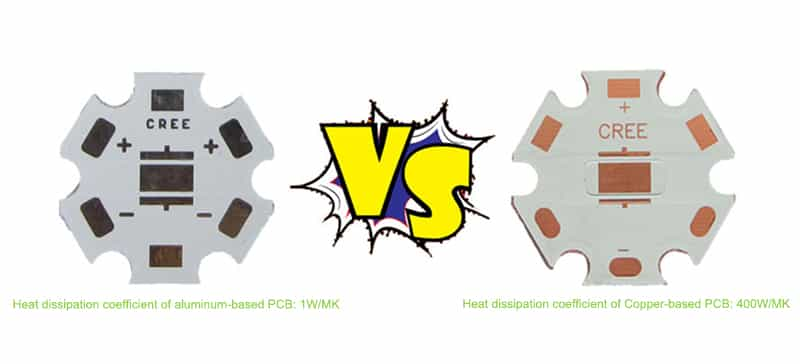
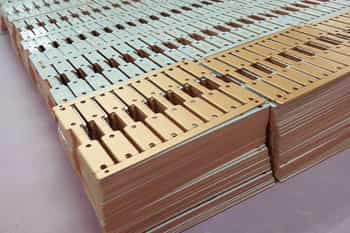
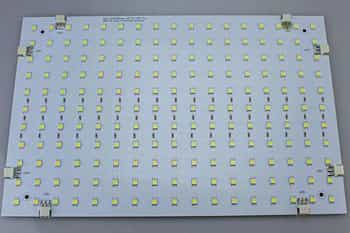
Copper Core PCB Applications
As a material with high thermal conductivity and heat dissipation, copper base PCBs are the best solution for high-power applications. When working with high-Tg projects, copper core PCBs offer the best thermal conductivity and heat dissipation.
Copper core PCBs were initially created for high-power switching supply, but they also have a significant presence in light-emitting diode (LED) applications, such as traffic lights. Copper base PCBs support higher-density designs, enabling more complex projects while operating at high currents.
Available applications include:
- Lighting: Streetlights, interior lighting, and camping lanterns
- Automotive: Headlights and power controllers
- Telecommunications: Filtering appliances and high-frequency amplifiers
- Audio: Output, input, and power amplifiers
- Computers: Central processing unit (CPU) boards and power devices
- Power supply: Solid-state relays, bridges, power rectifiers, and converters
- Medical tools: Operating room and surgical lighting, power converters, and high-power scanning technology
The complementary between the copper-based PCB and the aluminum PCB
We can feel that the competition between copper-based PCB and aluminum PCB is very fierce, but both have their market shares. Why is that?
1. Copper-based PCB is the most expensive of all metal substrates, while aluminum PCB costs are relatively low. Different users and different use environments can choose different substrates.
2. Copper-based PCB has a relatively long service life due to its intense heat dissipation and thermal conductivity. Therefore, copper-based PCBs are commonly used in areas with high requirements such as automotive lights, crewless aircraft, and industrial and mining lights.
The heat dissipation capacity of the aluminum PCB is about 1W-2W. Most of them are used for indoor lighting, which requires relatively low, low-power LED lights. Simultaneously, when used in homes, the cost is also one factor that needs to be considered.
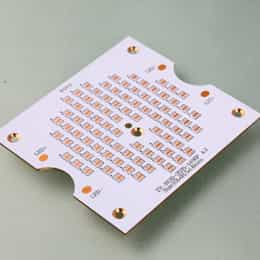
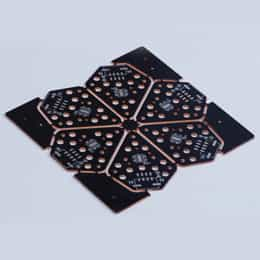
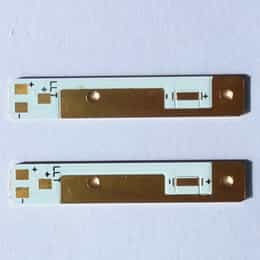
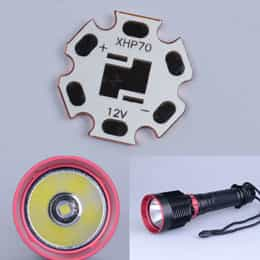
Copper Core PCB Design Guide
The minimum drilling diameter needs to be 0.4mm because of the thicker copper base; the copper foil’s thickness on the copper-based PCB determines how the line width and spacing are. If the copper foil is thicker, it will need a more expansive line width and larger minimum spacing.
Cost-saving is a prerequisite for copper-based PCB design, especially when designing irregular copper-based PCBs. Intricate circuit design mainly pay attention to the following factors: routing, aesthetics, assembly, heat, force, signal, and other requirements;
Force: The external force and vibration that the copper-based PCB receives during the working process, the size and position of the holes on the PCB Board need to be arranged reasonably, and the weakest surface of the board caused by the irregular holes should be sufficiently resistant to bending strength;
Routing, aesthetics, assembly: it needs to meet the customer’s visual sense.
Get Your Copper Based PCB Today!
JHY PCB is a one-stop solution to all your PCB needs. We have a large facility in Shenzhen, China. Our PCBs are compliant with safety and quality standards. We are RoHS, UL, and ISO certified. We provide all types of PCBs, including copper core PCBs, aluminum core PCBs, flexible PCBs, rigid-flex PCBs, and high Tg PCBs. We are also experts in full turnkey PCB assembly services. Our strict quality management system and experts ensure the quality of PCBs. There is no minimum order requirement, and you can get quick-turn prototypes. We can handle small medium and even large volume PCBs. For more information, feel free to contact us.
Frequently Asked Questions
A heavy copper PCB is the PCB that has more copper at the top layer. It does not need to be a copper core/metal core PCB. It can be made on FR-4.
The top layer PCBs is made from copper, no matter what type of PCB it is. The layer is responsible for the conduction and transmission of electric signals. It completes the circuit. In some cases, the copper at this layer is required more than the standard amount. If the amount of copper used is 4oz per square feet or more, then it is called a heavy copper PCB. There is also an extreme core PCB, which has a thicker layer of copper than a heavy core PCB. So, the term “heavy” is related to the amount of copper used on the PCB.
It is not necessary that the heavy copper PCB will have copper as the base material. Any PCB that has the defined amount of copper at the top layer can be called heavy copper PCB.
The thermal conductivity coefficient is defined as: per unit length, per K, how much energy can be transmitted in W, the unit is W/mK. Among them, “W” refers to the unit of thermal power, “m” represents the unit of length, meter, and “K” is the unit of absolute temperature. The larger the value, the better the thermal conductivity. Copper-based PCB is a unique metal-based copper clad laminate copper-based PCB, which has good thermal conductivity, electrical insulation performance, and mechanical processing performance. The thermal conductivity of copper-based PCB can be measured by testing instruments after the laminate is pressed.
Thermal conductivity is what everyone is concerned about: the faster the heat dissipation, the longer the product’s service life. The thermal conductivity of the copper-based PCB board is as high as 300W—450W. Copper-based PCBs are mostly used in car headlights, taillights, and other devices that require high heat dissipation; aluminum’s heat dissipation and thermal conductivity can only reach 1W—2W, and the cost is relatively low, so most of them are used in indoor lighting.
The aluminum PCB material is aluminum, heat dissipation ability is strong, so this kind of PCB board is often used in LED lighting products. It has both positive and negative sides; the white side is welding LED pins; the other side is aluminum color, which generally will be applied to the thermal conductive paste. Copper substrates, the most expensive metal substrates, conduct heat many times better than aluminum or metal core PCB. Copper foil with a thickness of 35 m~280 m is generally used because of the high current carrying capacity of the copper-based PCB circuit layer. Due to the differences between copper and aluminum and the corresponding PCB processing technology, copper-based PCB for LED automotive headlamps has more performance advantages than aluminum PCB.
Copper-based PCB was born according to people’s needs and had high heat dissipation function, so it is widely used.
- Appearance. Whether there is scratching of copper on the front of the PCB board and whether the ink used is of low quality.
- The most important thing is whether the bumps are flat.
- Check whether there is a separation between layers.
Copper is an essential part of printed circuit boards, such as Copper Clad Laminate (CCL) used in PCBs. Besides, The most common element used to make traces also is copper.
Why We Use Copper?
Firstly, the number one benefit of copper is that it is highly conductive. This means that it can easily transmit signals without losing electricity along the way.
Secondly, Copper is also readily available and relatively inexpensive.
Thirdly, Heat dissipation. The heat dissipation performance of copper is better than other metal materials.
Metal core PCBs, also known as MCPCBs, insulated metal substrates (IMS), or heat dissipation PCBs, is one of the most widely used PCBs today. The basic material used in Metal core PCB is metal, not FR4 or CEM3 material. The most commonly used metals are aluminum, steel alloys, and copper. Aluminum is cheap and has good heat dissipation capacity. Copper has better heat dissipation capacity than aluminum and stainless steel, but it is expensive. Stainless steel is harder than copper and aluminum but has a very low thermal conductivity. Therefore, the choice of metal cores will depend on the application in which they are used.
Copper is an essential part of printed circuit boards, such as Copper Clad Laminate (CCL) used in PCBs. Besides, The most common element used to make traces also is copper.
Why We Use Copper?
Firstly, the number one benefit of copper is that it is highly conductive. This means that it can easily transmit signals without losing electricity along the way.
Secondly, Copper is also readily available and relatively inexpensive.
Thirdly, Heat dissipation. The heat dissipation performance of copper is better than other metal materials.
Related Metal Core PCB Manufacturing Services
Related Posts
- Choosing the Right Metal Core PCB Manufacturer is Critical to Your Success
- Top PCB Board Manufacturer And Supplier In China
- The Best PCB Manufacturer In China
- Custom Circuit Board Printing
- Custom PCB Manufacturing In China
- Why choose FR4 as the general material of PCB?
- Why is FR4 Used to Make High Tg PCBs?
- What Is FR-4 Material In PCB Fabrication?


